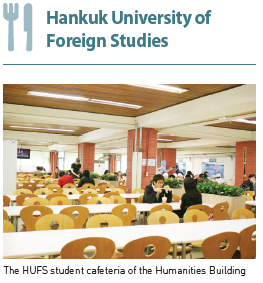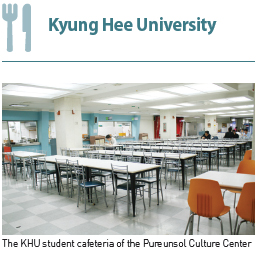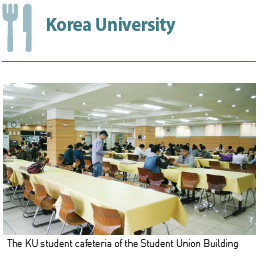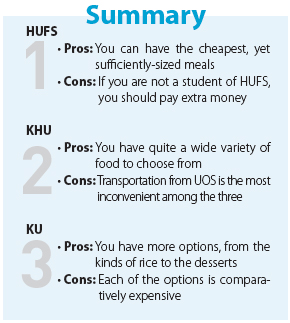If you are a student of the University of Seoul (UOS), your daily life probably involves coming to school, listening to lectures, eating lunch, drinking coffee, listening to lectures again and going back home. What I want to point out is that ‘eating’ is an essential and important part of your campus life. What do you eat every day? Do you go to the student cafeterias in the Student Hall or in the Dormitory? Or do you go to restaurants near campus? Some of you might be satisfied with meals you have at school, and some of you might not. I was curious about what and where students at other universities usually eat. I also wanted to know how much their meals cost. Thus, I visited three universities near UOS and found out the characteristics of each university’s cafeterias. Let me share them with you.The first university I visited was Hankuk University of Foreign Studies (HUFS). It is the closest university to UOS. If you walk there, it takes about 30 minutes. If you want to get there by bus, you should take 1222, 261, 147 or 120, and get off in front of the main gate of HUFS. It only takes about 10 minutes. Actually, there are several cafeterias at HUFS that students can use, including ones in the Humanities Building, the Faculty Office Building Ⅱ, the Dormitory Building and the Main Administration Building. Among them, I went to the one in the Humanities Building because it offers meals at the cheapest price. I looked forward to eating there because HUFS is famous for its student cafeteria’s cheap food with comparatively high quality. What I liked the most was the interior of the cafeteria. It was neater and cleaner compared to UOS’s.Another thing I liked was the costs of the meals. They ranged from 1,500 to 2,200 won. However, you have to pay extra if you are not a student of HUFS. What I ate for lunch was a bowl of rice topped with sweet and sour pork (tangsuyuk deopbap), which was originally 1,800 won for HUFS students. It was served with two side dishes and a soup. Two of my friends chose kimchi iced noodles and rice with kimchi and flying fish roe (kimchi albap) which was served with three side dishes and a soup. They cost 1,500 and 2,200 won respectively for HUFS students. We paid 2,500 won for kimchi albap because none of us were HUFS students. Generally, we were all satisfied with the amount of food and it all tasted great. An interesting thing about the HUFS student cafeteria was that its meal tickets were plastic and had various colors according to the costs of meals. Other than what we ate, it also offered gimbap, ramen, toast, rice cakes in hot sauce (tteokbokki) and sundae at cheap prices. The cafeteria offers breakfast from 8 a.m. to 10 a.m., lunch from 11 a.m. to 2:30 p.m. and dinner from 4:40 p.m. to 6:40 p.m. Noodles are offered from 11:30 a.m. to 2:30 p.m. In the case of options like gimbap and toast, they are offered from 8:20 a.m. to 6:40 p.m.Kyung Hee University (KHU) is another university near UOS. You can walk there in about 30 minutes. If you take the town bus 01 at Hoegi Station, you can get to KHU in 10 minutes. There are two student cafeterias at KHU. Between the one in the Cheongwoon Building and another one in the Pureunsol Culture Center, the former offers cheaper food than the latter. Because I could not find the Cheongwoon Building at that time, I visited the Pureunsol Culture Center and had fried rice wrapped in a thin omelette and bean paste soup with outer leaves (ugeojidoenjang soup).They were about 2,500 won each. I had a hard time making a decision because there were so many options on the menu, such as Chungmugimbap, hamburgers, ramen and rice cakes in hot sauce (tteokbokki). They were all less than 3,000 won. The omelette was served with a steak and a salad, and a soup was served with three side dishes and a bowl of rice. Because I got more than I could eat, I left half of it. Near the exit of the cafeteria was a cafe. A unique characteristic of the KHU student cafeteria was that it had contracted off-campus companies to prepare meals. It is open from 8 a.m. to 7 p.m. on weekdays and from 9:30 a.m. to 1:30 p.m. on weekends. Although I did not go to the cafeteria in the Cheongwoon Building, if you want to enjoy a cheaper meal at KHU, you may as well go there. It opens from 8:30 a.m. to 7 p.m. on weekdays and from 9:30 a.m. to 1:30 p.m. on weekends.
The last university I visited was Korea University (KU). To get there, you should take Bus 121 in front of UOS and get off at the Korea University Station. It will take about 15 minutes. At KU, there are many cafeterias because it has quite a large campus. They are ones in the International Studies Hall, the Student Union Building, the Living Plaza and the Techno-complex Research Center. I visited the one in the Student Union Building because it offers the cheapest items. When I got into the cafeteria, it was a little bit dark. There was a television that students watch while they eat. The most unique thing about the KU student cafeteria is the options students can choose from.First, you can choose from plain white rice or multigrain rice which is 50 won more expensive than the plain one. The menu for the day I visited KU included a soft tofu bibimbap, a rice-cake soup (tteokguk) with beef, a roasted mackerel pike, a salad with cereal flakes, a pan cake and so on. I tried to choose what to eat based on calories and the price. What I finally got was multigrain rice (600), a rice-cake soup with beef (1,000), a cubed radish kimchi (kkakdugi) (200), laver and an orange. My friend chose a soft tofu bibimbap (1,600), a soup (200), a chopped roast chicken with cheese (1,000) and a salad with cereal flakes (₩1,000). A unique characteristic of the KU student cafeteria was that it has various kinds of desserts such as oranges, puddings, baked eggs and candies. I thought choosing what I want to eat could save me some money, but the costs of the meals in total were actually expensive ? the most expensive among the three universities I visited. The operation hour is from 8 a.m. to 7 p.m. on weekdays and 9 a.m. to 2 p.m. on weekends.
With this general information of the student cafeterias of other universities near UOS, I recommend you to go there and enjoy what other students usually eat. Because it does not take much time to go and eat there, you can use your spare time between the classes. It might refresh you to get out of your daily routine and to experience a little part of the students’ lives at other universities. Also, comparing them with our student cafeteria could be interesting and eye-opening.
Kim Hyeon-ji Vice Editor-in-Cheif
s004405@uos.ac.kr








